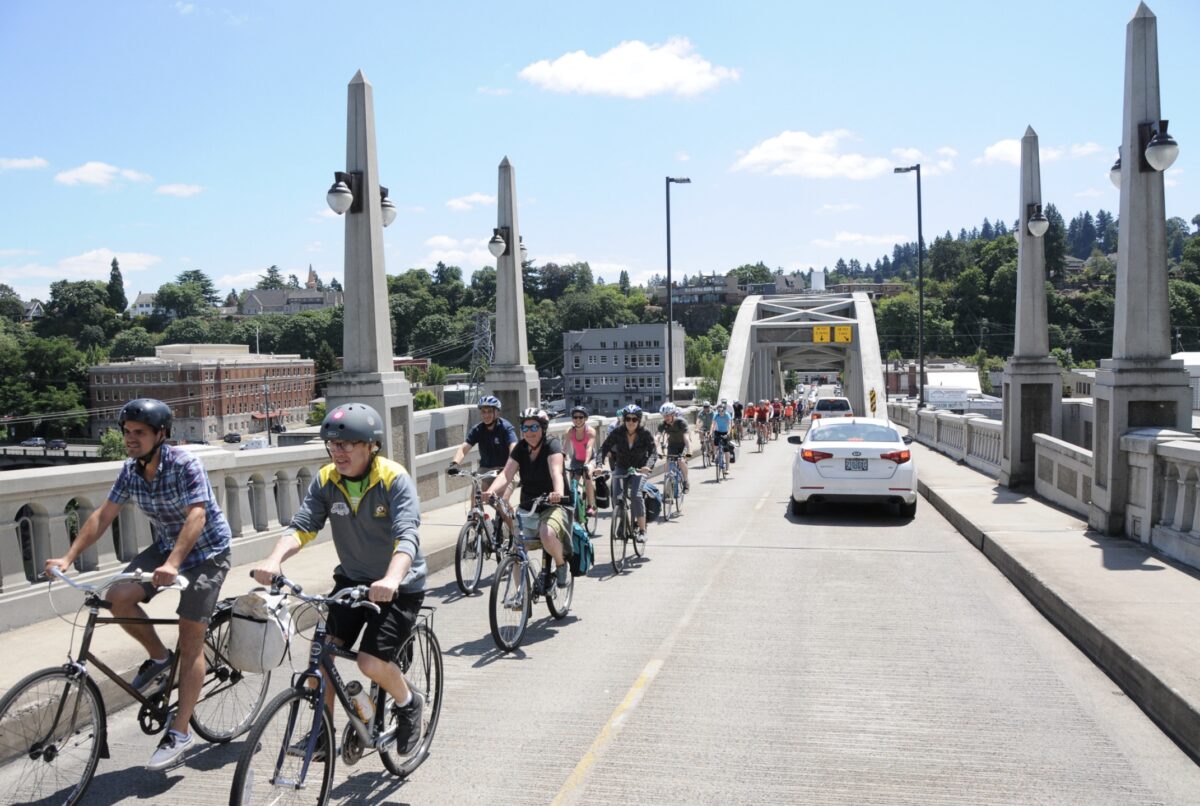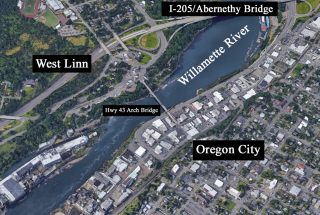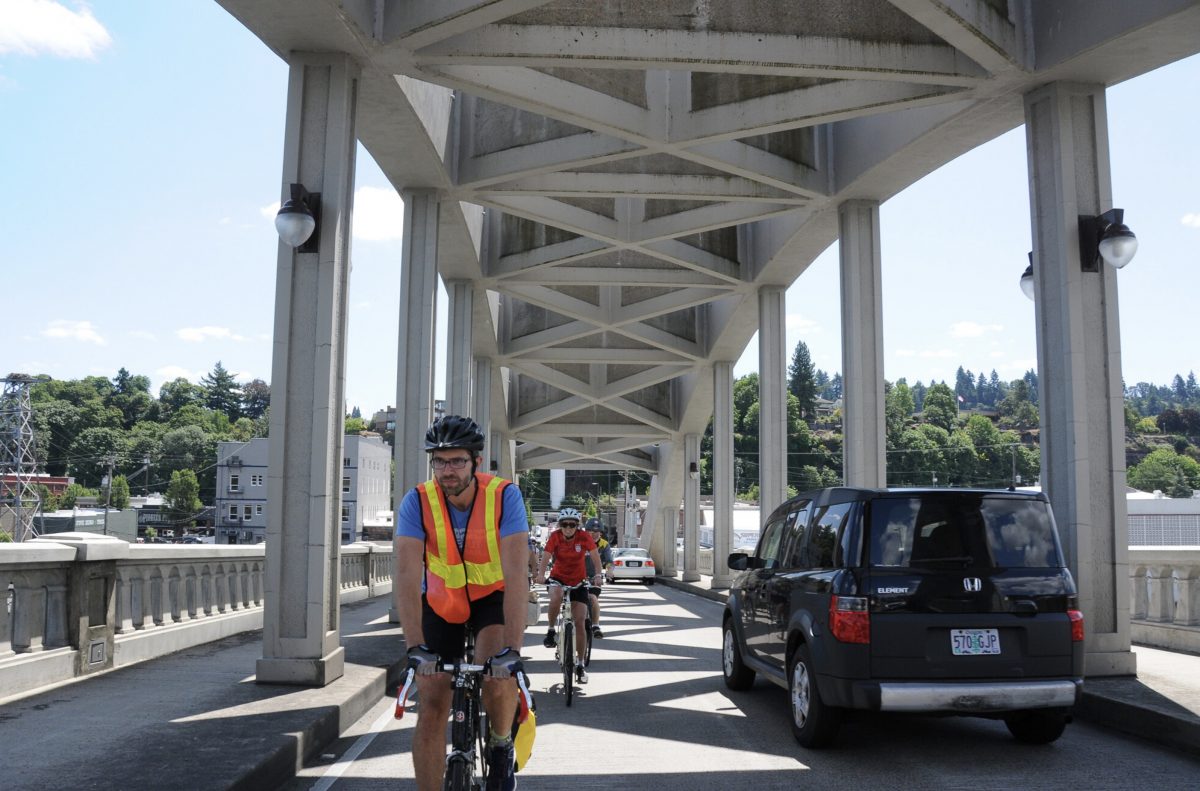
(Photos: Jonathan Maus/BikePortland)
On Thursday a Metro transportation advisory committee passed a resolution to explore the feasibility of a new carfree bridge over the Willamette River between Oregon City and West Linn.

With $350,000 in federal funding, the Oregon Department of Transportation will lead the effort in partnership with the cities of West Linn and Oregon City, Clackamas County and Metro. Of the two bridges that currently cross the river, one of them is Interstate 205 (Abernethy Bridge, where cycling is prohibited) and the other is the narrow Arch Bridge that has no dedicated space for cycling.
The feasibility study will consider whether a new bridge is necessary and if so, what the ideal location would be. The options on the table are a new bridge south of the existing Arch Bridge, north of the existing bridge (and south of I-205/Abernethy Bridge), or to simply not build a new bridge and instead make the Arch Bridge carfree.
“The existing pedestrian/bicycle connection on the Oregon City Arch Bridge is narrow and steep for the pedestrians and cyclists to use the same narrow travel lanes as the vehicles on this historic bridge.”
— Kristen Stallman, ODOT
ODOT Major Projects Manager Kristen Stallman shared with me via email this morning that a more human-centric crossing is in line with other efforts to reclaim the Willamette River from years of neglect and industrial use. “This area is steeped with natural and cultural history and identifying a new bridge corridor will require coordination and comprehensive planning that leverages the visioning set in motion by both of these cities as they look to redevelop their waterfronts and connection to the Willamette River,” Stallman said.
A quiet and safe bridge for walkers, bicycle riders and rollers of all types would be a natural complement to the Willamette Falls Legacy Project which seeks to create a new riverwalk in coordination with The Confederated Tribes of Grand Ronde, who were displaced from the land by Oregon settlers in the late 19th century. The tribe’s sacred fishing and living grounds were replaced by paper and timber mills that have sat mostly idle for decades.


Advertisement

Here’s more from the Metro Staff Report:
This planning effort supports community desires to connect the regional active transportation network in this area. The existing Arch Bridge (OR 43) does not adequately serve bicycle and pedestrian connectivity within the vicinity. The planned I-205 Abernethy bridge will not allow bicycle and pedestrian use. Further, agency partners are interested in identifying a new option for a low stress connection between the two cities… A new pedestrian and bicycle bridge will enhance access for people walking and biking and provide the region opportunities to reconnect with the river and identify a key missing connection in the regional bikeway and pedestrian system. Completing the active transportation network with a bridge creates essential access to and along the Willamette River between Gladstone, Oregon City, and West Linn.
It’s worth noting that ODOT is currently planning to widen the Abernethy Bridge as part of a $500 million project on I-205. Some members of ODOT’s Bicycle and Pedestrian Advisory Committee (OBPAC) have wondered whether ODOT is flouting the state’s Bike Bill (which requires a minimum investment and accommodation for bicycle users on all major highway reconstruction projects) by not building a parallel bike path. The committee estimates the bike paths would add $20 to $50 million to the cost of the project; but ODOT has said the expense is, “disproportionate to the use and need”. ODOT’s current proposal is to force bicycle riders to use highway shoulders which would be widened as part of the project. A nearby bridge for bike riders would get the OBPAC (and a potential Bike Bill lawsuit) off ODOT’s back.
In 2012 ODOT added sharrow pavement markings to the deck of the bridge. In July 2019 regional elected officials and policymakers (including Metro President Lynn Peterson) rode bicycles over the Arch Bridge as part of a day-long tour of the area.
“The partners recognize the existing pedestrian/bicycle connection on the Oregon City Arch Bridge is narrow and steep for the pedestrians and cyclists to use the same narrow travel lanes as the vehicles on this historic bridge,” Stallman added. She also said the public outreach process for the project will start very soon and that it will, “Hopefully result in a vision for an enhanced crossing of the Willamette River in an extremely important location and necessary next steps.”
— Jonathan Maus: (503) 706-8804, @jonathan_maus on Twitter and jonathan@bikeportland.org
— Get our headlines delivered to your inbox.
— Support this independent community media outlet with a one-time contribution or monthly subscription.

